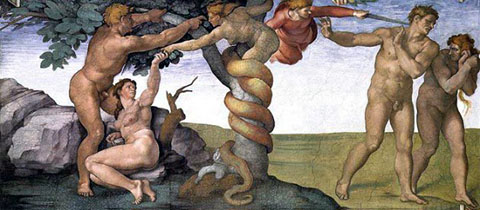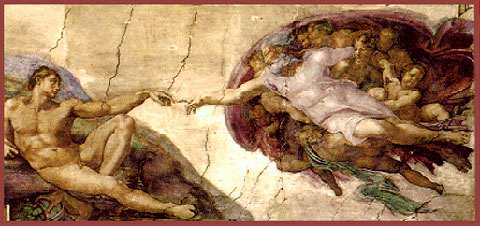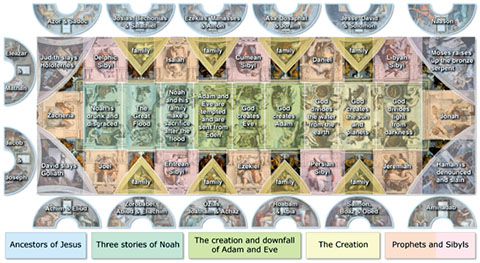 The Sistine Chapel ceiling, painted by Michelangelo between 1508 and 1512, is a cornerstone work of High Renaissance art.
The Sistine Chapel ceiling, painted by Michelangelo between 1508 and 1512, is a cornerstone work of High Renaissance art.
The ceiling is that of the Sistine Chapel, the large papal chapel built within the Vatican between 1477 and 1480 by Pope Sixtus IV, for whom the chapel is named. It was painted at the commission of Pope Julius II. The chapel is the location for papal conclaves and many important services.
The ceiling’s various painted elements form part of a larger scheme of decoration within the Chapel, which includes the large fresco The Last Judgment on the sanctuary wall, also by Michelangelo, wall paintings by several leading painters of the late 15th century including Sandro Botticelli, Domenico Ghirlandaio and Pietro Perugino, and a set of large tapestries by Raphael, the whole illustrating much of the doctrine of the Catholic Church.

Central to the ceiling decoration are nine scenes from the Book of Genesis of which The Creation of Adam is the best known, having an iconic standing equalled only by Leonardo da Vinci’s Mona Lisa, the hands of God and Adam being reproduced in countless imitations. The complex design includes several sets of individual figures, both clothed and nude, which allowed Michelangelo to fully demonstrate his skill in creating a huge variety of poses for the human figure, and have provided an enormously influential pattern book of models for other artists ever since.
To reach the chapel’s ceiling, Michelangelo designed his own scaffold, a flat wooden platform on brackets built out from holes in the wall near the top of the windows, rather than being built up from the floor. Mancinelli speculates that this was in order to cut the cost of timber. According to Michelangelo’s pupil and biographer Ascanio Condivi, the brackets and frame that supported the steps and flooring were all put in place at the beginning of the work and a lightweight screen, possibly cloth, was suspended beneath them to catch plaster drips, dust and splashes of paint. Only half the building was scaffolded at a time and the platform was moved as the painting was done in stages. The areas of the wall covered by the scaffolding still appear as unpainted areas across the bottom of the lunettes. The holes were re-used to hold scaffolding in the latest restoration.
Contrary to popular belief, he painted in a standing position, not lying on his back. According to Vasari, “The work was carried out in extremely uncomfortable conditions, from his having to work with his head tilted upwards”. Michelangelo described his physical discomfort in a humorous sonnet accompanied by a little sketch.
Michelangelo wrote a poem describing the arduous conditions under which he worked:
I’ve grown a goitre by dwelling in this den–
As cats from stagnant streams in Lombardy,
Or in what other land they hap to be–
Which drives the belly close beneath the chin:
My beard turns up to heaven; my nape falls in,
Fixed on my spine: my breast-bone visibly
Grows like a harp: a rich embroidery
Bedews my face from brush-drops thick and thin.
My loins into my paunch like levers grind:
My buttock like a crupper bears my weight;
My feet unguided wander to and fro;
In front my skin grows loose and long; behind,
By bending it becomes more taut and strait;
Crosswise I strain me like a Syrian bow:
Whence false and quaint, I know,
Must be the fruit of squinting brain and eye;
For ill can aim the gun that bends awry.
Come then, Giovanni, try
To succour my dead pictures and my fame;
Since foul I fare and painting is my shame.
——————————————————-
Nine scenes from the Book of Genesis:

Along the central section of the ceiling, Michelangelo depicted nine scenes from the Book of Genesis, the first book of the Bible. The pictures fall into three groups of three alternating large and small panels.
The first group shows God creating the Heavens and the Earth. The second group shows God creating the first man and woman, Adam and Eve, and their disobedience of God and consequent expulsion from the Garden of Eden where they have lived and where they walked with God. The third group of three pictures shows the plight of Humanity, and in particular the family of Noah.
The pictures are not in strictly chronological order. If they are perceived as three groups, then the pictures in each of the three units inform upon each other, in the same way as was usual in Medieval paintings and stained glass.[34] The three sections of Creation, Downfall and Fate of Humanity appear in reverse order, when read from the entrance of the chapel. However, each individual scene is painted to be viewed when looking towards the altar. This is not easily apparent when viewing a reproduced image of the ceiling, but becomes clear when the viewer looks upward at the vault. Paoletti and Radke suggest that this reversed progression symbolises a return to a state of grace. However, the three sections are generally described in the order of Biblical chronology.
The scenes, from the altar towards the main door, are ordered as follows:
- The Separation of Light and Darkness
- The Creation of the Sun, Moon and Earth
- The Separation of Land and Water
- The Creation of Adam
- The Creation of Eve
- The Temptation and Expulsion
- The Sacrifice of Noah
- The Great Flood
- The Drunkenness of Noah